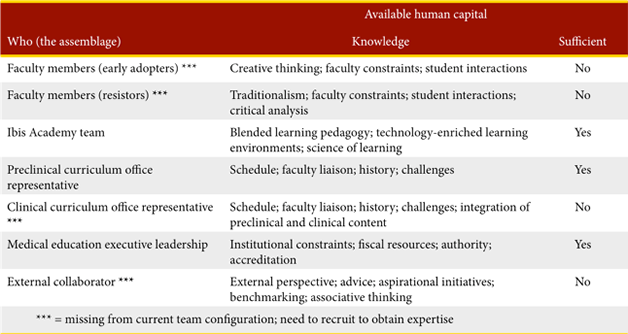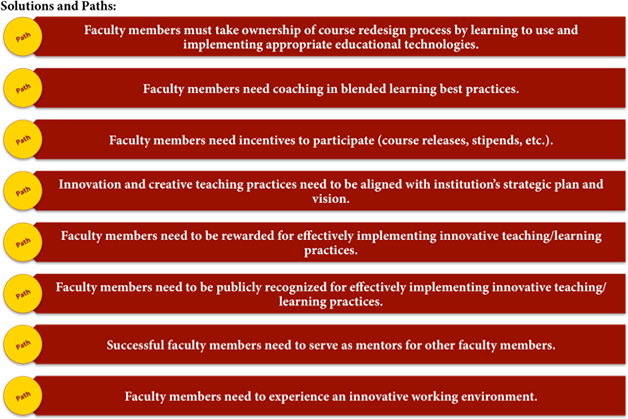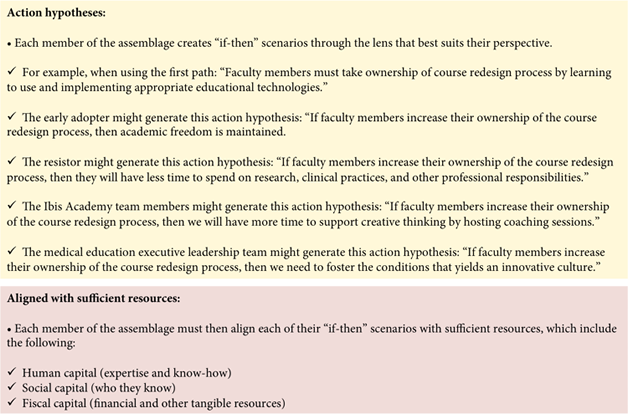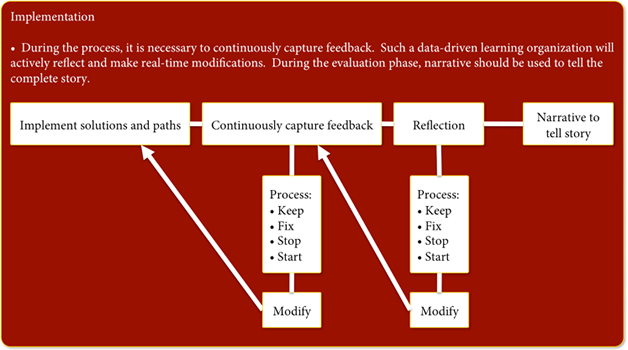Action maps can help identify and procure the resources needed to sustain the kinds of initiatives that can transform higher education.

Sustaining technology-enriched learning initiatives has the potential to transform higher education. However, it is often challenging to obtain the necessary human capital to implement successful strategies that adequately represent all stakeholders. Using a case study from a private medical school on the East Coast as the backdrop, this action map describes how an assemblage of stakeholders could use action hypotheses to ensure that sufficient resources align with effective implementation of academic transformation initiatives.
This site-specific example stemmed from coursework at the University of Southern California Rossier School of Education's Organizational Change and Leadership program. This work is also a subcomponent of my dissertation, "A Gap Analysis of Course Directors' Effective Implementation of Technology-enriched Course Designs: An Innovation Study." Within this resource, action-mapping phases are listed below, explained, and contextualized with a relevant example from the case study site (pseudonym = Ibis Academy).
Phase 1: Generate the Performance Goal
The action map needs to align with a single specific performance goal, which should be concrete, challenging, and current.
Case Study Example:

Phase 2: Inventory the Current Assemblage of Human Capital
Begin by creating a matrix. In the first column, list all team members needed for the assemblage of stakeholders who will perform some role in achieving the performance goal. In the second column, explain the knowledge each team member brings to the assemblage. In the third column, indicate whether each stakeholder has sufficient expertise. Then, inventory the assemblage and identify knowledge gaps and assemblage recruitment needs.
Case Study Example:

Phase 3: List Solutions and Paths
List the relevant organizational solutions (or paths that members of an assemblage may take independently or in breakout groups) that will help the team achieve the performance goal.
Case Study Example:

Phase 4a: Generate Action Hypotheses
Each member of the assemblage generates and lists if-then scenarios (action hypotheses) through the lens that best suits their unique perspective. Each of these scenarios should align with the performance goal.
Phase 4b: Align the If-Then Scenarios with Sufficient Resources
Organizational resources include human capital (expertise and know-how), social capital (who they know) and fiscal capital (financial and other tangible resources). Once the if-then scenarios are generated, each must be aligned with sufficient resources. This helps identify potential gaps, needs, or barriers that could hinder achievement of the performance goal.
Case Study Example:

Phase 5: Implementation, Evaluation, Reflection, and Storytelling
Finally, the solutions and paths are implemented. Data-driven learning organizations continually collect data during this process. During evaluation, reflection and real-time modifications are essential. One example of real-time process modification includes keep (what's working), fix (what's not working), stop (what can't be fixed), start (new solutions that emerge). Then, compelling narrative through storytelling should be used to communicate successes and failures in an open and transparent manner.
Case Study Example:

David P. Green is a senior instructional designer, who recently completed his EdD at the University of Southern California University Rossier School of Education.
© 2018 David P. Green. The text of this work is licensed under a Creative Commons BY-NC-ND 4.0 International License.
